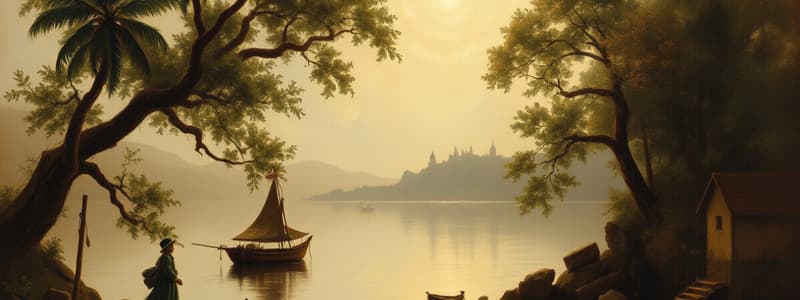Podcast
Questions and Answers
Who is the supreme god in Philippine mythology?
Who is the supreme god in Philippine mythology?
- Bathala (correct)
- Tala
- Mayari
- Apolaki
The Monkey and the Tortoise is an example of a fable that conveys a moral lesson.
The Monkey and the Tortoise is an example of a fable that conveys a moral lesson.
True (A)
What is the significance of the term 'Alamat' in relation to the stories mentioned?
What is the significance of the term 'Alamat' in relation to the stories mentioned?
It refers to legends or traditional stories in Filipino culture.
The tale of how the _____ came about involves a young man's envy towards a woman's chosen suitor.
The tale of how the _____ came about involves a young man's envy towards a woman's chosen suitor.
Match the following terms with their definitions:
Match the following terms with their definitions:
Who is known as the 'father of Tagalog Plays'?
Who is known as the 'father of Tagalog Plays'?
The literature from the pre-colonial period of the Philippines was mainly written and not oral.
The literature from the pre-colonial period of the Philippines was mainly written and not oral.
What are 'salawikain' commonly used for?
What are 'salawikain' commonly used for?
The folk song 'Dandansoy' is an example of ______.
The folk song 'Dandansoy' is an example of ______.
Match the following forms of literature with their descriptions:
Match the following forms of literature with their descriptions:
Flashcards are hidden until you start studying
Study Notes
Philippine Literary History Overview
- Philippine literature has evolved from pre-colonial times to contemporary eras, influenced by geographical, linguistic, and ethnic dimensions.
- Geographic dimension relates to the characteristics of a specific region.
- Linguistic dimension involves different languages and forms used in literary works.
- Ethnic dimension refers to cultural groups sharing common traits such as language and customs.
Severino Reyes
- Born on February 11, 1861, and died on September 15, 1942.
- Known as "Lola Basyang," he was a prominent Filipino playwright.
- Authored 26 zarzuelas and 22 dramas, earning titles as the "father of Tagalog plays" and the "father of Tagalog zarzuela."
Pre-Colonial Period
- Existed before Spanish colonization (1500s).
- Primarily oral literature reflecting ancient Filipino life.
- Literature was sourced from local townsfolk.
Forms of Literature in Pre-Colonial Period
- Riddles: Metaphorical statements posed as questions, e.g., "Kay lapit na sa mata, di mo pa nakikita."
- Proverbs (Salawikain): Short sayings conveying universal truths, e.g., "Kung ano ang puno siya rin ang bunga."
- Myths: Traditional stories explaining natural events and beliefs.
- Legends: Accounts regarded as historical but unverified.
- Fables: Stories using animals to impart morals.
- Epics: Long narratives recounting heroic deeds, like "Biag ni Lam-ang."
Philippine Mythology and Deities
- Featured gods like Bathala (supreme god) and Mayari (goddess of the moon).
- Other gods include Tala (stars), Apolaki (sun), and Lakapati (fertility).
Major Publications through Eras
- Spanish Period: Newspapers like "El Heraldo dela Revolucion" and "La Independencia."
- American Period: Works such as "Liwayway" and "Bannawag" flourished, addressing social issues and painting realistic portrayals of life.
- Japanese Period: Literature focused on Filipino language, creative works reflected social injustices and nationalism.
The Republic and Subsequent Periods
- 1941-1945: Period marked by literary revival in Tagalog highlighting struggles against Japanese rule.
- 1946-1970: Post-liberation saw an explosion of literary forms, including enhanced poetry and realistic short stories.
- 1970-1972 (Period of Activism): Youth-led expressions fueled by demands for government change emerged in literature.
- 1972-1980 (New Society): Literature reflected themes of patience, respect for culture, and nature amid ongoing societal changes.
- 1981-1985 (Third Republic): Poetry became romantic and revolutionary, exploring themes of grief, aspirations for freedom, and love.
- 1986-1995 (Post-EDSA 1 Revolution): A new era of Philippine literature marked by significant cultural shifts evident in media and public expressions.
Studying That Suits You
Use AI to generate personalized quizzes and flashcards to suit your learning preferences.




